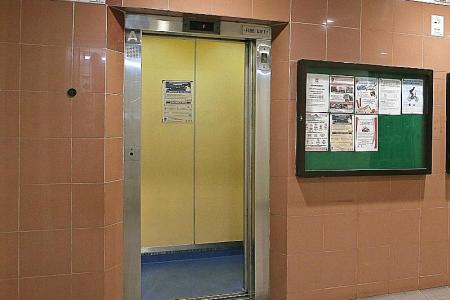Over 18,500 lifts to be upgraded in 10 years
They will have better safety features such as high-tech sensors
More than 18,500 lifts within Housing Board estates will be modernised with better safety features such as high-tech sensors and emergency communication equipment over the next 10 years.
Of these, around 17,000 are lifts managed by the People's Action Party (PAP) town councils, and 1,500 lifts will be upgraded in the next 15 months, the 15 PAP town councils said in a joint statement.
Works on the remainder will be carried out progressively over the next 10 years.
Around 1,500 lifts within the Workers' Party-run Aljunied-Hougang Town Council (AHTC) will also be upgraded over the next 10 years, a spokesman said in a separate statement, adding that around 180 are scheduled for upgrading in the next 15 months.
These lifts will be upgraded with modern safety features under the $450 million Lift Enhancement Programme (LEP) funded by the HDB.
The joint statement said the PAP Lift Task Force, which was formed in 2016, had completed its review of the lifts with contractors.
Coordinating MP for PAP town councils, Dr Teo Ho Pin, who led the task force, said the town councils will upgrade only one lift a block at any one time, with each upgrade taking about two weeks. This will minimise inconvenience to residents.
"...Residents will be notified in advance of the shutdown," he said.
The PAP town councils managed some 24,000 lifts as of last month, and the WP's AHTC more than 1,700.
The HDB programme will equip lifts with recommended components by the Building and Construction Authority (BCA).
The PAP town councils have also adopted new working protocols to manage tenders and contractors, and is testing a new system to help town councils manage their lifts.
A lift surveillance system giving round-the-clock information on lift breakdowns is on schedule to be implemented, said Dr Teo.
The HDB programme extends to lifts less than 18 years old at the start of the LEP.
Older lifts may be considered for replacement under a different scheme, said Dr Teo.
Veteran lift engineer Kok Peng Koon, 80, agreed lifts more than three decades old would have suffered so much corrosion and wear that it would be more feasible to replace them entirely than to upgrade them.
With most lifts slated for upgrading, experts said this would serve as an incentive for private and commercial lift owners to follow suit and adopt BCA's list of recommended components.
Mr Chee Yan Pong, 73, who owns consulting engineering firm YP Chee and Associates, said commercial parties will have to do so on their own dime.
"Rather than through mandate, this is a softer, more progressive way to teach private lift owners to upgrade their lifts," said Mr Chee.
The eight safety components were recommended by the BCA in 2016, following a number of HDB lift incidents that caused death or injury.
They include sensors, a battery-powered automatic rescue device that can release trapped users safely during lift breakdowns and power failures.
One of the features to be installed is overspeed protection, which can detect whether an ascending lift has accelerated beyond its design limit, braking the lift car before it hits the top of the lift shaft.
Get The New Paper on your phone with the free TNP app. Download from the Apple App Store or Google Play Store now


